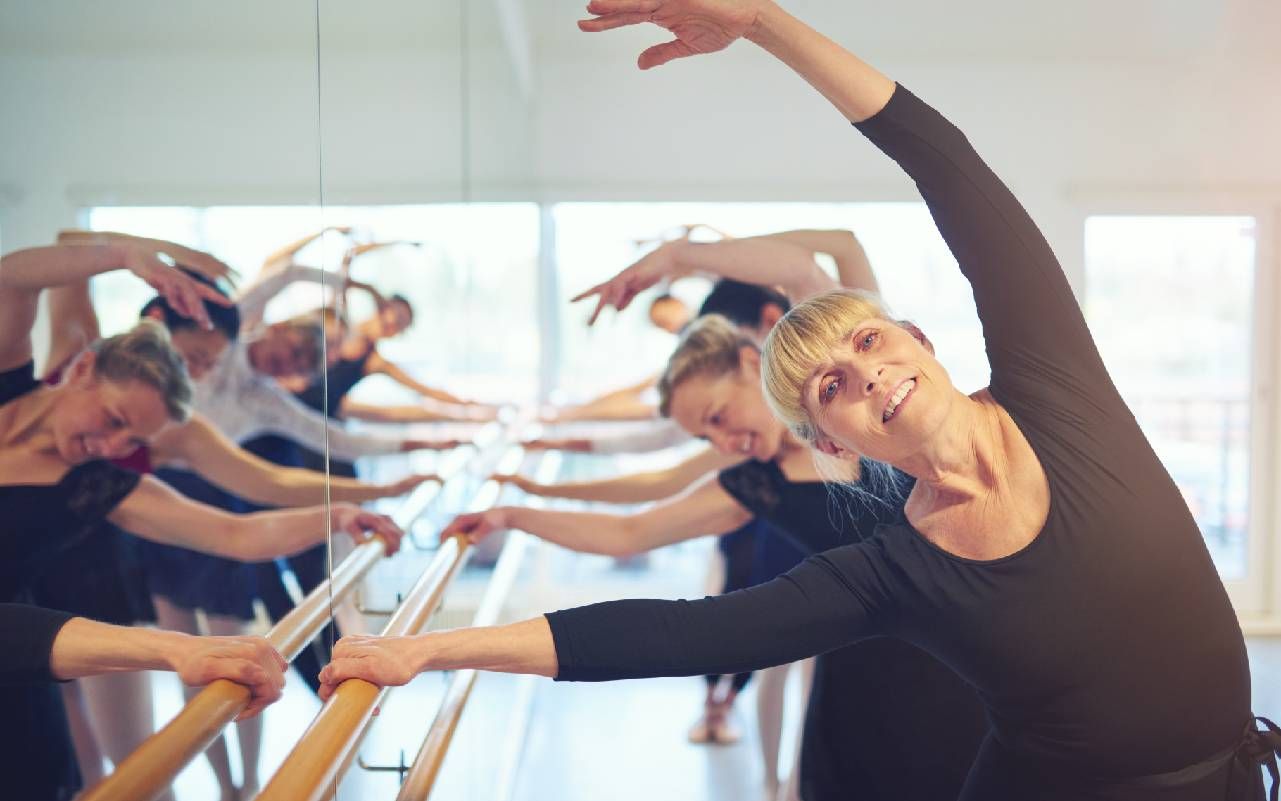Ballet Is for All Bodies: No Tutus Required
Dance can strengthen your bones, improve your balance, boost your memory and help foster community
At Open Door Studios in Charlotte, North Carolina, you'll see adult dancers of all ages memorizing combinations, stretching their limbs and smiling during a 90-minute ballet class — lots and lots of smiling.

"I love it," says Sonia Alvarez Wilson, 66, a retired schoolteacher and a longtime ballet enthusiast.
Ballet is both a cardiovascular and a weight-bearing exercise.
"It is a lifelong sport," she says, explaining how she's taken ballet class sporadically since she was a kid. But doing it as an adult has become a next-level passion for Wilson, who credits dance with helping to ease her joint pain.
"I get achy joints when I don't dance," she laughs. While donning a pair of ballet slippers and taking a spot at the barre may traditionally be considered something just for kids and teens to pursue, adults can benefit from it in ways that might surprise you.
All About the Bones
Ballet is both a cardiovascular and a weight-bearing exercise. Instead of dumbbells or weight machines, your body is used as resistance when doing stationary exercises like arabesques and pliés.
The shift to cardio comes later in the class, when dancers move to the center for jumping and leaping across the floor.
"Ballet is great for strength, through the hips and the core."
Kester Cotton, a physical therapist and the dance program coordinator at Spaulding Outpatient Center in Wellesley, Massachusetts, says ballet is excellent for sustaining bone health which is an important issue for women in particular, especially as they reach menopause age and lose bone mass and density.
According to the National Institute on Aging, osteoporosis affects about one in five women over the age of fifty. "Ballet is great for strength, through the hips and the core," Cotton says.
Body Beautiful, Brain Beneficial
If you think ballet is just for super flexible, bendy bodies, think again. Ballet is for anyone who wants to give it a go, whether you took classes as a kid and are just now returning to it as an adult or if you're a newbie.
"Somebody new to ballet is going to get a good workout no matter what because it's hard and they're unlikely to be trying to strive for something other than just trying to learn the steps and get a workout," Cotton says.
If you think ballet is just for super flexible, bendy bodies, think again.
Be prepared to work your body and your mind. In "Dancing and the Brain," a Harvard Medical School publication from 2013, scientists cite studies that show dance helps reduce stress and boosts the feel-good hormone serotonin.
Dance also helps to "develop new neural connections, especially in regions involved in executive function, long-term memory, and spatial recognition." In a 2020 study, researchers found that female recreational ballet dancers report feeling ballet "can foster both a positive social identity and affect that engenders efficacy in managing successful aging."
Additionally, the study shows that "dancers did not self-categorize as 'old,' and they enjoyed positive intergenerational relationships. Overall, participants described and discussed fondly how they hope to continue dancing for as long as they can."
Ballet has become more inclusive across the United States with many studios offering adaptive dance for people with disabilities and courses geared explicitly toward Parkinson's patients. In another study, researchers found the benefits of dance include "improved balance and gait function as well as improved quality of life."
Fostering Connections
Once students feel more comfortable with the basic ballet terminology and how their bodies feel making moves that may be new to them, ballet class can become like a second home."I enjoy the community and most people are super welcoming and friendly," Wilson says.
Jacqueline White, a ballet teacher and the owner of Open Door Studios, loves working with adults because they choose to take classes, unlike younger students.
"It's the drive and the instinct to keep going. We can laugh and have fun," she says. White especially likes teaching classes with a diverse range of ages and abilities. "There's so much to be learned by the younger students and teenagers, especially watching adults who might struggle and still push through it. Who might laugh and go, 'Oh, I messed up!'"
Ballet class has the added plus of being a distraction-free environment which is something that's lost in today's tech-saturated world. "Nobody brings their phones in here," says White, motioning to her airy, spacious studio. "Nobody's checking their texts. We are really in tune with each other. We're dancing at the same time to the same music."
Feel-Good Vibes
For students like Wilson, who can't imagine their lives without ballet, it's truly the ultimate in connecting the mind, body and spirit. "Your mind has to be present," she says. "To understand the vocabulary, to think about the steps in order and remember the choreography."
"Nobody's checking their texts. We are in tune with each other. We're dancing at the same time to the same music."
Cotton stresses the trifecta, too. "Anytime you do an activity that integrates you with your body, and also in the space around you, and with other people, there is a nice connection that happens there. An activity you can do with a group of people can be very motivating."
Wilson says all of the benefits of dance keep her coming back and she tries to take class twice a week. "I just know that it's for me, and for my health, wellbeing, mental, physical…all the benefits of dance. Just being able to modify it to do what's right for me," she says.
For her, not dancing isn't an option. "Dancing is in my blood. I'm just hoping that I can just do it indefinitely."
A Final Note on Strengthening Exercises
Remember: Take it slow, and remember to stretch. If you want to dip your toe (or ballet slipper) into ballet, Cotton stresses the importance of easing into it, regardless of age or fitness level.
In particular, dedicated hip and core strengthening exercises and stretching can help to improve balance and coordination, which will help you at the barre and in the center, where the jumps and more prominent movements take place.
As for specifics, the clamshell exercise, lateral leg raises and side-lying hip abduction are great for targeting the legs and hips. Other exercises include donkey kicks, hamstring bridges and the elbow plank for working the hip flexors and your core.
Another thing to consider is spine articulation, and for that, Cotton recommends the Pilates roll-down. You'll also want to prep your feet and calves. One thing to try is toe yoga — spread your toes apart to see if you can raise your big toe while keeping the other toes flat. Then, keep your big toe still while the others are lifted.
Cotton also suggests doing these strength exercises about a month before starting ballet classes. Your body will thank you for the prep work.


